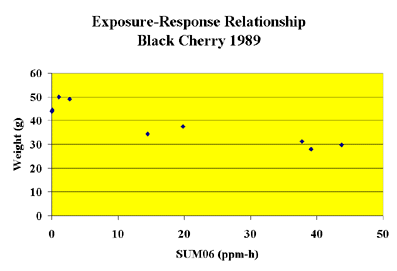For the tree seedling data, individual Weibull models
were fit to each harvest separately. A Weibull regression model
was fit to relate tissue biomass with ozone exposure. The figure
to the right is an example of yield data obtained in a black
cherry experiment performed at Appalachian State University,
Boone, NC in 1989. Open-top chambers were used in the experiment.
The "y" axis is the yield information (in units of
grams) and the "x" axis is the experimental-period
SUM06 experienced in each of the chambers. Each data point represents
a different ozone level and response as a function of the the
treatments used in the experiment.

The basic Weibull yield-response model was used in
the A.S.L. & Associates analysis because it was flexible
and accommodated a range of data patterns. A Weibull equation
of the following form was used:

The three constants, A, B, and C represent (1) the
theoretical yield at zero ozone, (2) the scale parameter on ozone
exposure and reflects the exposure at which expected response
is reduced to 0.37 A, and (3) the shape parameter affecting the
change in the rate of loss in expected response, respectively.
The x value is the value for the exposure index (e.g., W126 or
SUM06) in parts-per-million hours (ppm-h) units.
In the example above, the average weight of the plants
in each chamber was used with the SUM06 value experienced in
the chamber in fitting the data to a Weibull model. The resulting
model provided a way to relate ozone exposure in terms of the
SUM06 index with predicted growth loss.
In the analysis performed by A.S.L. & Associates
, the Weibull Equations for several vegetation species were used
to predict growth loss. However, because the original experimental
data derived from the open-top chambers also contained numerous
high hourly average concentrations (i.e., equal to and above
0.10 ppm), specific attention was given to these high hourly
average concentrations.
Returning to the original experimental data, A.S.L.
& Associates examined the number of hourly average concentrations
equal to and above 0.10 ppm experienced in each chamber for each
experiment. Using this information, A.S.L. & Associates developed
separate models that related the number of hourly average concentrations
equal to and above 0.10 ppm to the experimental W126 or SUM06
exposure experienced.
In completing the analysis, A.S.L. & Associates
combined (a) the information using the Weibull models that predicted
growth loss for a specific species in a specific experiment as
a function of ozone exposure (e.g., W126) with (b) the predicted
number of occurrences equal to and greater than 0.10 ppm. Thus,
the predicted species losses were based on a dual-parameter exposure
index--
W126
and
Number of hourly
average concentrations equal to and greater than 0.10 ppm.
The resulting growth-response curves in the analysis
for each species for each year were shown with the growth loss
on the "y" axis, the cumulative W126 or SUM06 exposure
index on the "x" axis, and the number of occurrences
equal to and greater than 0.10 ppm at the 10%, 20%, 30%, etc.
growth loss levels that would have to occur. The N100 value at
each level of predicted loss was placed on each data point on
the curve.
Thus, taking a hypothetical case, if:
The ambient ozone level in a specific area in
the region experienced a W126 exposure value of 40 ppm-h and
only 1 occurrence of an hourly average concentration equal to
and greater than 0.10 ppm
and
Using experimental data, the Weibull model predicted
a growth loss of 23% for a specific species grown in the area
when the W126 exposure value was 40 ppm-h
and
Using the experimental data, one found that 45 occurrences
of hourly average concentrations equal to and greater than 0.10
ppm had to occur at the W126 value of 40 ppm-h.
It is more than likely little growth loss would occur
under ambient conditions in the area within the region
because of a lack of peak concentrations.
The reason for this prediction is because the ozone
exposure under ambient conditions showed infrequent occurrences
of the high hourly average concentrations that were present in
the original open-top chamber experiments. As noted in the report,
EPA emphasized in the Ozone Criteria Document that the higher
hourly average concentrations should be treated differently than
the mid- and low-level hourly average concentrations. The higher
hourly average concentrations should be provided greater weight
when assessing possible vegetation effects. Ignoring the presence
of the numerous peaks in the open-top chamber experiments essentially
treats all hourly average concentrations the same. This is an
incorrect application of the findings stated in the Ozone Criteria
Document and the conclusions drawn in the peer-review literature.
